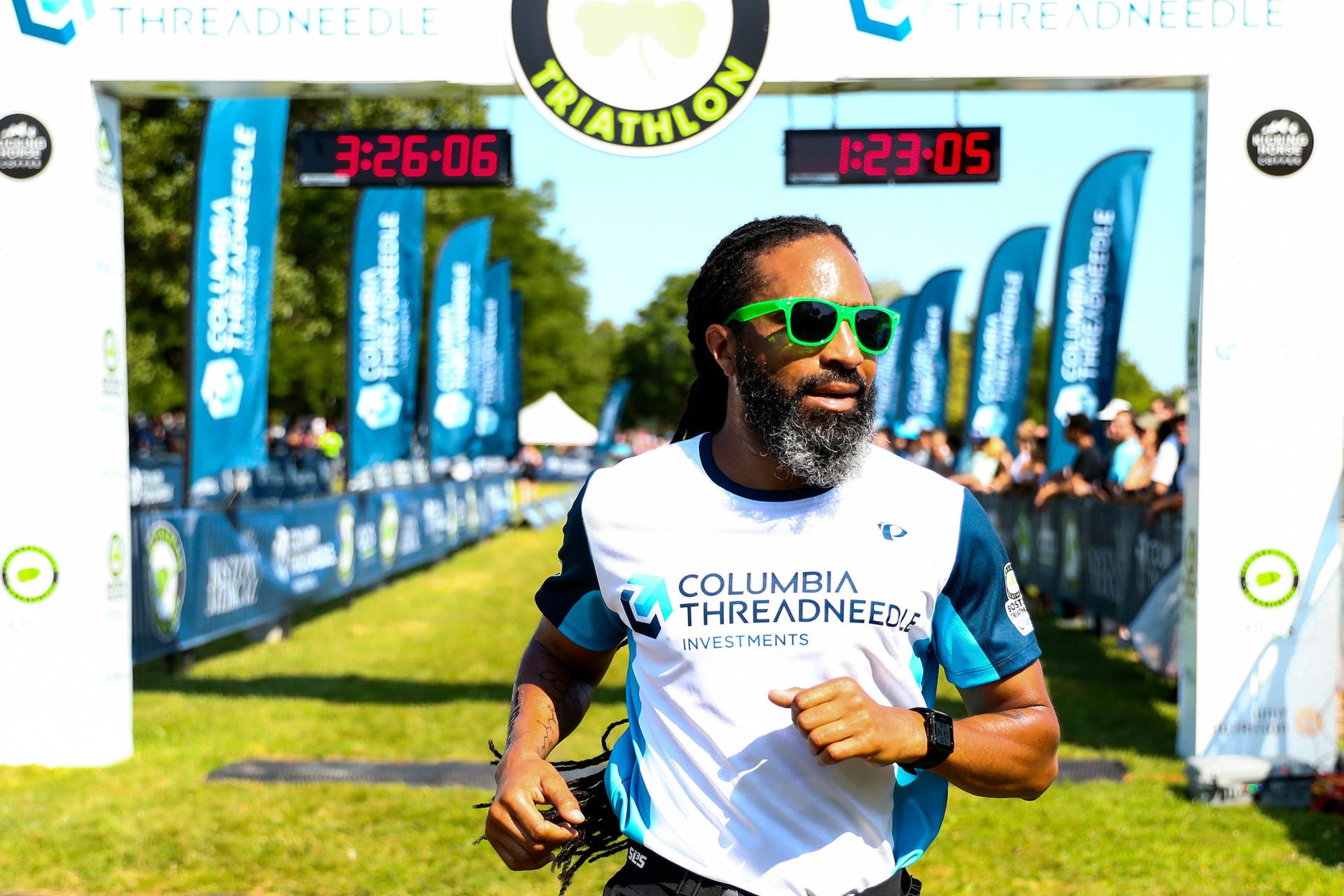Understanding Cutoff Times in Triathlon

(Photo: Danny Weiss/Triathlete)
It doesn’t matter if you’re doing a sprint triathlon or an Iron-distance race – the first time you take on a new triathlon distance, there’s probably going to be a bit of concern about cutoff times. After all, making your way through a new (or new-to-you) challenge comes with many unknowns: Will I be able to swim that far? Is that hilly bike course going to slow me down? What happens if I fall apart on the run? And, perhaps the biggest question of all: Can I finish before the cutoff?
RELATED: Triathlete’s Guide To Your First Triathlon
What are cutoff times in triathlon?
At most triathlon races, there are various points on course that athletes must pass by a certain time of day. At the minimum, these will be at the transitions from swim to bike and from bike to run (also known as T1 and T2), plus the finish line. If an athlete does not arrive at these locations by the cutoff time, they will be asked to exit the race.
It might sound cruel to pull an athlete from a race for being slow, but triathlon cutoff times are not designed to shame athletes; instead, they’re a safety issue.
“Cutoff times are in place to help meet road closures and permitting requirements on our courses and at our venues,” said Beth Atnip, vice president of global operations at Ironman. “Daylight is also a factor in cutoff times, as we need to maintain safe course conditions.”
“We use cutoff times to ensure that people get on (and off) the roads as quickly as possible,” said Brennan Lindner, race director for the Herbalife24 Triathlon Los Angeles. “As Los Angeles is the traffic capital of the U.S., we work closely with L.A. Department of Transportation to close the roads, and then get them open quickly and traffic moving before Los Angeles really wakes up.”
Most races must get permits from their host city to close off roads for the event, and these permits are time-bound. Closing roads is an inconvenience for residents of that town, and too many complaints about lengthy closures might mean permits for future races are not approved by the host city (you can learn more about that here: What Does It Take to Close the Roads for a Triathlon?). Additionally, races often have to pay police officers to direct traffic and ensure cars do not bypass road closure signs to enter the course—this costs money, which translates to higher entry fees for athletes racing.
RELATED: Why Is Triathlon So Expensive?
Cutoff times are also a way to ensure athletes can get the support they need while racing. For a sprint triathlon, which takes most people less than two hours to complete, it’s not an issue to set up a few aid stations and ask volunteers to work at them for the duration of the race. In longer events like half-Iron races (which can take over five hours to complete) or an all-day Ironman, aid stations are set up, stocked, and staffed during the times athletes will be on that particular part of the course. Cutoff times for athletes are also a way of letting staff and volunteers know, definitively, when they’ll be done with their shift instead of asking them to give up more of their day for the last few athletes to come through.
Typical triathlon cutoff times, by distance
Sprint distance triathlon cutoff times
| Swim | 30 minutes after start |
| Bike | 2 hours after start |
| Run/Finish | 3 hours after start |
Olympic distance triathlon cutoff times
| Swim | 1 hour after start |
| Bike | 3 hours, 15 minutes after start |
| Run/Finish | 4 hours, 30 minutes after start |
Half-iron/70.3 cutoff times
| Swim | 1 hour, 10 minutes after start |
| Bike | 5 hours, 30 minutes after start |
| Run/Finish | 8 hours, 30 minutes after start |
Full-iron/Ironman cutoff times
| Swim | 2 hours, 20 minutes after start |
| Bike | 10 hours, 30 minutes after start |
| Run/Finish | 17 hours after start |
Though most race distances follow the same general template for cutoff times on the swim, bike, and run, there might be individual variations based on the location or permit rules. Challenge Roth, for example, is a full-Iron distance race that enforces a 15-hour cutoff time for the finish line due to late-night noise ordinances in the host city. Other races have rolling cutoff times within the bike or run courses to allow for the reopening of roads.
“Our bike cutoff is varied, as athletes must pass certain intersections by a reasonable amount of time,” Lindner said, about the L.A. Triathlon course. “The most critical intersections are in West Los Angeles, as there is not a freeway overpass. Athletes need to pass Lincoln Blvd. before 8 a.m., the 405 Freeway by 8:30 a.m., and La Brea and Olympic by 9 a.m. All cyclists need to be off the course by 10 a.m.”
Most races will let their athletes know about cutoff times on their race website or in their race rules (usually sent out via email in the weeks before a race and verbally disseminated during pre-race briefings at packet pick-up). If you are unsure of the cutoff times for your race, contact the race director via email, phone, or social media.
Can I keep going if I miss a cutoff time?
Because most races are bound by the terms of their permits, cutoff times are usually pretty strictly enforced, and an athlete who is wearing a bib number and timing chip must abide by the rules of the race.
“For most of our races across our Ironman and Ironman 70.3 event series, we maintain global consistency with our cutoffs,” Atnip said. “However, there are a very small number of circumstances that require an individual event to make minor adjustments to the standard cutoff times.”
Race officials might allow an athlete who arrives at T2 five minutes after a cutoff to start the run, with the understanding that they’ll have to make up that time with a speedier run. Others might allow athletes to cross the finish line after the cutoff time, but their official time might be recorded as “DNF” (Did Not Finish) in the official race results, and that athlete might not receive a finisher medal. Again, this varies from race to race (and even from racer to racer).
RELATED: What Happens at the Back of the Pack?
Not every race uses cutoff times

At the Boston Triathlon, race director Michael O’Neil feels strongly about cutoff times—namely, that athletes shouldn’t have to worry about them. That’s why he’s worked hard with permitting officials to expand road closure permits to eliminate cutoff times.
“This is something that has made our event more approachable to beginner athletes, which is important to us,” O’Neil said.
This does sometimes lead to pushback at times. Last year, as O’Neil relayed information to traffic safety officers about a few slower athletes making their way to the finish line, officials responded, “Well, we are going to re-open the road, and they can just run on the sidewalk.”
“With all due respect,” O’Neil responded, “I have over an hour left on my permit, so we will keep these roads closed until these athletes finish.”
Foregoing cutoff times is part of a years-long initiative by the Boston Triathlon to grow the sport by making it more accessible and approachable for all. By eliminating cutoff times, O’Neil says many potential triathletes move from “reluctant” to “all-in.”
“This is a huge accomplishment for these people,” he said, which is why he insists on giving every athlete the same race-day experience, regardless of finishing time. “We do not want to minimize that accomplishment.”
Resources for making race cutoff times
Find coaching tips, workouts, and sample paces to make the cutoff times at your next triathlon with our guides: